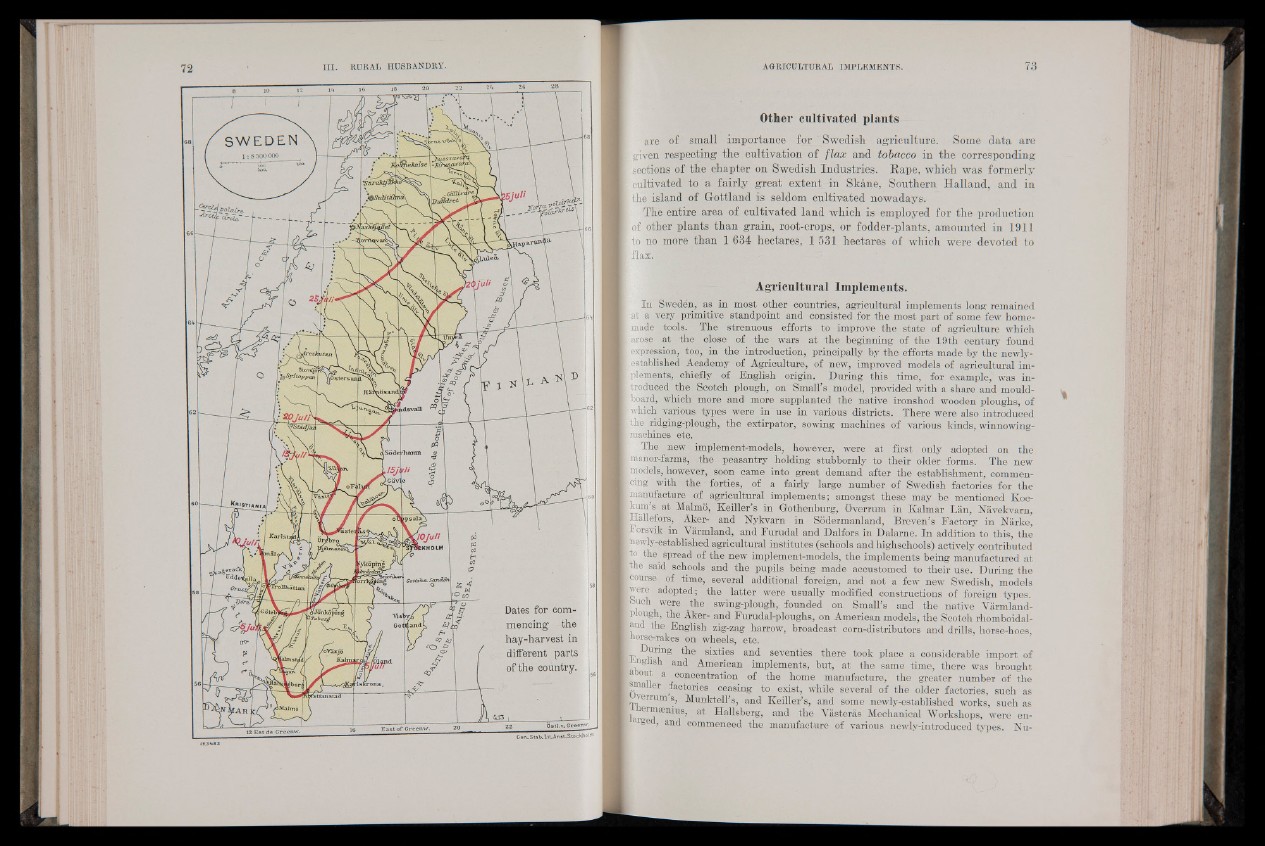
tossavi
. Gällivorz
ì u t f d r e t TJ
resAt/tan
SlOTI
fe S y lto p p e lo s t e r su n 1
H äm ö s a n d
So d e "hanui
KRISTIA!
K a r ls ti
’I roH h ä tta n
Dates for commencing
-the
hay-harvest in
different parts
of the eoùntry.
GöteM oJonköping
tTab e r g
Isti arista 3
»Malmö
G s tl.v . GreenW.
Geru SiaV. LicAn s t. S to ckholm
Other cultivated plants
are of small importance for Swedish agriculture. Some data are
given respecting the cultivation of flax and tobacco in the corresponding
sections of the chapter on Swedish Industries. Rape, which was formerly
cultivated to a fairly great extent-in Skane, Southern Halland, and in
the island of Gottland is seldom cultivated nowadays.
The entire area of cultivated land which is employed for the production
of other plants than grain, root-crops, or fodder-plants, amounted in 1911
to no more than 1 634 hectares, 1 531 hectares of which were devoted to
flax.
Agricultural Implements.
In Sweden, as in most other countries, agricultural implements long remained
at a very primitive standpoint and consisted for the most part of some few homemade
tools. The strenuous efforts to improve the state of agriculture which
arose at the close of the wars at the beginning of the 19th century found
expression, too, in the introduction, principally by the efforts made by the newly-
established Academy of Agriculture, of new, improved models of agricultural implements,
chiefly of English origin. During this time, for example, was introduced
the. Scotch plough, on Small’s model, provided with a share and mould-
board, which more and more supplanted the native ironshod wooden ploughs, of
which various types were in use in various districts. There were also introduced
the ridging-plough, the extirpator, sowing machines of various kinds, winnowing-
machines etc.
The new implement-models, however, were at first only adopted on the
manor-farms, the peasantry holding stubbornly to their older forms. The new
models, however, soon came into great demand after the establishment, commencing
with the forties, of a fairly large number of Swedish factories for the
manufacture of agricultural implements; amongst these may be mentioned Koc-
kum s at Malmo, Keiller’s in Gothenburg, Overrum in Kalmar Lan, Navekvarn,
Hallefors, Aker- and Nykvarn in Sodermanland, Breven’s Factory in Narke,
Forsvik in Varmland, and Furudal and Dalfors in Dalarne. In addition to this, the
newly-established agricultural institutes (schools and highschools) actively contributed
fto the spread of the new implement-models, the implements being manufactured at
sabl schools and the pupils being made accustomed to their use. During the
pourse of time, several additional foreign, and not a few new Swedish, models
?q0rf ffd°Pted; the latter were usually modified constructions of foreign types,
puch were the swing-plough, founded on Small’s and the native Varmlanda
u B | I B | ^ Furudal-ploughs, on American models, the Scotch rhomboidal-
amd the English zig-zag harrow, broadcast corn-distributors and drills, horse-hoes,
porse-rakes on wheels, etc.
F B s*xt*es an(* seventies there took place a considerable import of
nghsh and American implements, but, at the same time, there was brought
a out a concentration of the home, manufacture, the greater number of the
jca er factories ceasing to exist, while several of the older factories, such as
verrum s, Munktell’s, and Keiller’s, and some newly-established works, such as
j rmajnius, $f Hallsberg, and the Yasteras Mechanical Workshops, were en-
| arged, and commenced the manufacture of various newly-introduced types. Nu